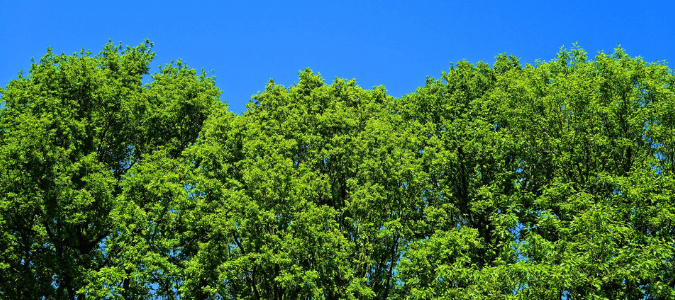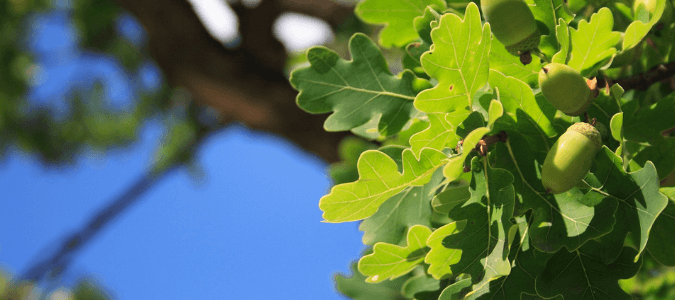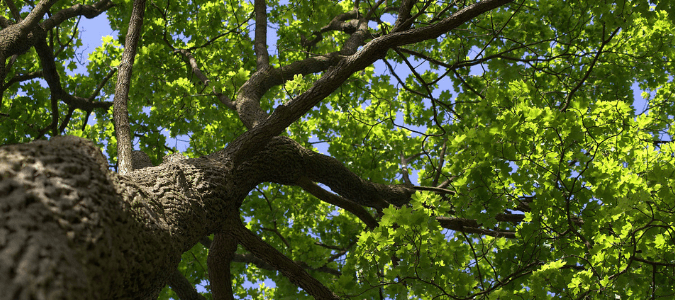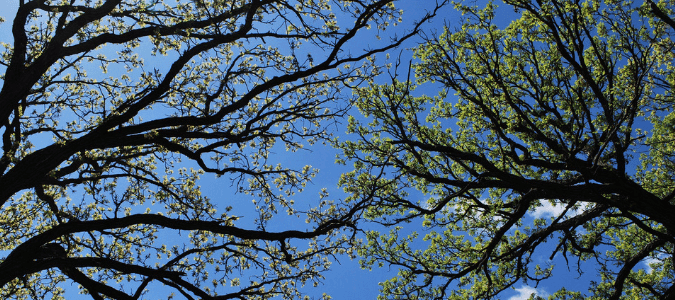Tree Crowning: Is It Good Idea Or A Mistake?

One of the things that drew you to your home was the beautiful trees. Perhaps you’ve never really had much of a green thumb, so you left the trees to their own devices. So far, that hasn’t been a problem.
Recently, though, you’ve noticed that those gorgeous trees have gotten a bit out of control. Where once they were uniform and well-manicured, now there are random branches jutting out here and there, giving your trees a ragged, lop-sided appearance.
You’ve considered dragging yourself up on your ladder to cut the offending branches. You’ve heard there is a technique called “tree crowning”, but you’re not really sure exactly how to do it—or even whether it would be a good thing to do.
The most important thing we can convey is that tree crowning is very rarely recommended by reputable lawn care experts. Although it may achieve your aesthetic goals, tree crowning will often damage your trees. In fact, many companies require you to sign a waiver if you request this type of tree trimming be performed. Most tree care experts will recommend alternatives to tree crowning in a majority of cases to handle overgrowth or a dense canopy.
Below, we’ll answer some of the most common questions people ask about crown reduction, topping trees and tree thinning and let you know how you should handle these issues.

The Importance Of Pruning (And Timing)
If you’re nervous about cutting into your trees, we get it. For someone who’s never done it before, tree maintenance can seem confusing and daunting. What is pruning, and is it the same as trimming? Can you hurt your tree? What if you mess up and it looks worse? And, to be fair, these scenarios can happen—and often do.
How can you reduce your chances of causing a problem? By learning all you can about tree maintenance.
Here’s what you need to know above all else: All trees need to be pruned from time to time. In fact, the more regularly you trim a tree, the better off your they will be. Moreover, trimming and pruning mean the same thing.
Before we go into any more detail about when and how to do so, understand that trimming your trees “regularly” does not mean all the time. While very light pruning can be done pretty much whenever, there are specific times of the year that are better for pruning, as well as times to avoid.
Depending on when you prune, your tree will respond differently, so it is important to think about your goals and be strategic about this necessary component of tree maintenance.
WINTER PRUNING
Most people prune during the winter months. During this time of year, most trees are essentially dormant, so if you trim and cut off branches at this point in the year, the most likely result will be a burst of new growth in the spring.
SUMMER PRUNING
Cutting in the summer, right after the main growing season has ended, gives you the ability to guide the growth of your trees a bit more. How so? There are a couple of reasons for this.
The first is that, unlike in the winter, summer cuts reduce the amount of food your tree gets by removing their food production source: leaves. Less food slows growth and forces your tree to focus on the most important areas.
In addition, summer pruning enhances your ability to shape your tree because it is much easier to locate problem branches and areas in the summer when the tree is in full bloom. You can more easily target those branches that are jutting out oddly or bowing under the weight of their leaves and remove them.
One thing you should not do: prune in the fall. Why? Because doing so puts your trees more at risk. Not only do cuts heal more slowly, increasing the chance that your trees could become infested or infected, this is also the time of year when decaying fungi spread their spores.
Why You Should Prune And Trim Your Trees
So, what are the specific benefits of pruning and trimming your trees regularly?
TO REMOVE PROBLEM BRANCHES
As trees grow, some branches die. This is normal and natural, but if you leave them on the tree, it can also be dangerous, and in extreme cases, even deadly. Dead branches are prone to falling. If a strong storm passes through, they can get tossed around by the wind.
Engaging in regular pruning and trimming will give you the opportunity to notice and take care of any problem branches on your tree before they create a serious issue. If left unchecked, these limbs can damage your property and put your friends, neighbors and family in danger.
TO PREVENT THE SPREAD OF DISEASE
Trees get diseases just like people. Also, just like with people, the goal is often to stop an infection from spreading.
Most of the time, doctors don’t lop off someone’s arm—or toe—to stop a disease from entering the rest of the body. With trees, however, that can actually be a useful practice. If a small section of a branch or tree is infected, often the best way to treat the problem is to simply remove the infected part.
TO ENCOURAGE GROWTH
As long as you keep it to a minimum, cutting into a tree sends a signal to stimulate growth, so pruning and trimming can help your trees grow faster.
TO IMPROVE FRUIT PRODUCTION
When you prune a fruit tree, more spurs can grow. Fruits are produced from spurs, so more spurs mean more fruits for the following year.
TO IMPROVE YOUR TREE’S BEAUTY (AND YOUR VIEW!)
Most homeowners don’t pay much attention to their trees—that is, until they begin to look a bit ragged and out of shape. Proper pruning and trimming is the easiest way to remedy that situation. You can shape your trees to make sure they are as aesthetically pleasing as possible, which can improve the entire exterior of your home.

Benefits of Topping Trees: Are They A Myth?
One reason that many homeowners have become more reticent about trimming their trees in recent years is because of the well-deserved backlash against topping trees. Simply put, the traditional practice of topping, whereby tree branches are cut back to scrubs indiscriminately, is ugly and unhealthy for the trees themselves. This practice also lowers the plants’ overall value.
If at all possible, you should not do top your trees. If a tree service advocates the wholesale cutting back of branches, you should be asking a bunch of questions. That being said, there are a few isolated situations where a version of topping might not only be necessary, but beneficial.
AVOIDING POWER LINES
This is probably the most common reason given for extensively cutting back the top branches of trees—because otherwise, these towering giants would grow into power lines, putting you at serious risk for a fire or other electrical damage.
In many recent developments with underground wiring, this isn’t an issue anymore. However, if you live in an older neighborhood and your tree is at risk of becoming entangled with power lines, that is absolutely a valid reason to cut off the top of the tree.
That being said, there are so many potential problems that topping can bring that your best bet is to let an experienced professional handle it, so they can minimize any issues you might encounter while trying to do the right thing.
PREVENTING STORM DAMAGE
Sometimes, trees with unchecked branch growth may be more susceptible to damage if a particularly strong storm comes through with the power to use that leverage. Topping can make storm damage less likely—or at least minimize your risk.
FIXING A LEANING PROBLEM
Rarely, a tree might grow in such a way that makes it lean one way or another. Over time, this can become a huge problem, even leading to the death of the tree. Skillful topping can be used to alter the tree’s center of gravity and stop the leaning.
Outside of these specific situations, however, you should always work to find an alternative to topping your trees. Even if you are dealing with the issues mentioned above, an experienced tree expert can often suggest better ways to handle them.

Crown Reduction: Tree Trimming Tips
Another potentially damaging technique is a crown reduction. This approach involves extensively pruning all along the outer edge of a tree’s branch growth, essentially making the entire “crown” (the branches and leaves that extend out from the trunk) smaller.
Trimming a tree in this manner puts a lot of stress on the tree because the cuts are not made at a natural boundary, and it can increase the chances of disease and decay. While a crown reduction is considered a better alternative than topping, it is still not recommended in most situations, because there’s a better way: tree thinning.

Tree Thinning Methods
What is tree thinning? This tactic allows you to selectively remove specific branches from the crown of a tree to make it less dense. This trimming improves sunlight penetration, reduces stress on the tree and makes the tree more resilient during a storm.
Wondering how to trim a tree? Here are the typical steps most tree experts follow:
- First, clean the canopy using a handsaw or a small chainsaw.
- Avoid removing branches from the interior. Instead, cut off branches no bigger than 1-3” in diameter from the outside and middle portions of main branches.
- Resist the urge to remove too much. Never cut more than 15-20 percent of live foliage at once. Often 5-10 percent is enough, especially on trees that are mature.
- Try to remove branches that are competing with other branches in the canopy or that are close to nearby branches and growing parallel.
ABC Is Your Answer For Safe, Healthy Tree Maintenance
Ultimately, the best method for healthy, beautiful trees is to engage in periodic structural pruning. At ABC, our experienced professionals are well-versed in all the best techniques. Want to learn more about how we can help your trees reach their full potential?
from AAA Tree Lopping Ipswich https://ift.tt/2o3sUk1
via IFTTT
No comments:
Post a Comment